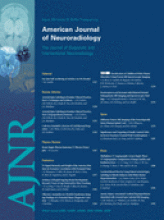R.J. Nijenhuis. Nieuwegein, Maastricht, the Netherlands: Drukkerij Anraad; 2007, 192 pages. 120 illustrations.
For the reader searching for a thorough summary of recent investigations and results of noninvasive imaging of the vascular supply to the spinal cord (in control and disease populations), the publication of the PhD thesis of Dr. Robbert J. Nijenhuis has yielded a precious gem. In addition to a brief introduction and conclusion/summary, there are 8 chapters in this 192-page book; 6 have been, and 2 will soon be, published in the American Journal of Neuroradiology, the Journal of Magnetic Resonance Imaging, or the Journal of Vascular Surgery. Dr. Nijenhuis and colleagues approached the task of imaging the spinal vasculature by first characterizing the level and appearance of the “Adamkiewicz artery” (AKA) on dynamic contrast-enhanced (CE) MR angiography (MRA) of the thoracolumbar spine before thoracoscopic microdiskectomy (Chapter 2). This “screening” for the level of the AKA resulted in a change in the side of the surgical approach in 2 of the 8 patients. Subsequently, Dr. Nijenhuis’ work focused on optimization and documentation of the vascular signal intensity from spinal arteries in patients scheduled for elective thoracoabdominal aortic aneurysm (TAAA) repair: Chapter 3 (gadolinium-diethylene-triaminepentaacetic acid versus gadobutrol for spinal MRA), Chapter 4 (differentiation of spinal cord arteries and veins by CE MRA), Chapter 6 (MRA of the AKA and anterior radiculomedullary vein: postmortem validation), and Chapter 8 (MRA and neuromonitoring to assess spinal cord blood supply in TAAA). As becomes evident from the TAAA studies and from work published by other investigators, differentiating between major intradural arteries and veins requires high temporal and high spatial resolution images, on the order of one 3D volume acquisition every 3–10 seconds. Dr. Nijenhuis and colleagues have explored these challenges in their more recent work: Chapter 5 (MRA of the AKA validated by digital subtraction angiography) and Chapter 9 (value and limitations of MRA in spinal arteriovenous malformations and dural arteriovenous fistulas). Nijenhuis’ recent work also includes a comparison between CE MRA and CT angiography (CTA) for the preoperative localization of the AKA in TAAA patients (Chapter 7). CE MRA was found to be preferable to CTA, because the former had a higher AKA detection rate, a higher vascular contrast-to-noise ratio, and relative insensitivity of AKA detection to patient girth.
In this book, most of the images that display the millimeter-sized intradural vessels are curved multiplanar reformations (MPRs) of sagittal source images from elliptic-centric encoded 3D CE MRA. The quality of the images ranges from excellent to “passing”; however, just the detection of these small spinal vessels is a formidable achievement. Dr. Nijenhuis and colleagues do a good job of illustrating their criteria for distinguishing major intradural arteries (AKA and anterior spinal artery [ASA]) from intradural veins (anterior median vein [AMV] and great anterior radiculomedullary vein). In one approach, 3D CE MRA data are acquired in 2 successive phases or frames (“two-phase MRA”). A vessel with intensity that is high in the first phase and decreases in the second phase (20–30 seconds later), and extends from the segmental artery to a hairpin curve on the anterior midline of the cord, is the AKA. In Chapter 4, the reader “sees” how difficult it is to temporally separate the arteries and veins, requiring 3D acquisition times of less than 10 seconds per 3D volume. With technical modifications that lower the time to 6 seconds (time-resolved MRA), temporal resolution was achieved; however, spatial resolution suffered. Nevertheless, the advanced MRA techniques used by Nijenhuis have more clearly shown the challenges that lie ahead in spinal vascular imaging. Not the least of these is distinguishing between the ASA and the AMV, which typically course side by side in the anterior median sulcus.
Two features of this book that I find attractive are the figure legends, which describe the imaging findings in great detail, and the abundant use of arrows and the clarity of labels, which direct the reader to the appropriate findings. Although there are only 2 schematic illustrations of the thoracolumbar spinal vascular anatomy, these are adequate to identify the major intradural vessels displayed on the MRA and CTA curved MPRs. Perhaps because it is not an obvious confounder of the anterior cord vascular anatomy as detected by CE MRA, the posterior median vein (PMV) is not shown on the curved MPR images nor is it included in the schematic drawings of the vasculature. This is curious, because the PMV is typically the largest vessel on the thoracolumbar cord surface when there is a “singlet configuration” of cord drainage.
Based on articles published in the radiology literature, the primary clinical applications of spinal MRA to date are the detection of the presence and level of spinal dural fistula and, more recently, screening for the level of the AKA in patients being evaluated for surgical or stent-graft repair of TAAA. Both of these applications use valuable noninvasive techniques that have the potential to decrease morbidity and mortality significantly. The work of Dr. Nijenhuis and collaborators, as extensively illustrated in this thesis, provides in-depth coverage of the latest developments in the field of spinal vascular imaging. No textbook covers this material as thoroughly, and any investigator working in this field or neuroradiologist wishing to become conversant in these technique will benefit from a careful reading of Nijenhuis’ thesis.

- Copyright © American Society of Neuroradiology












